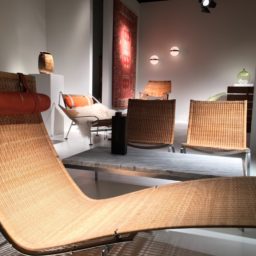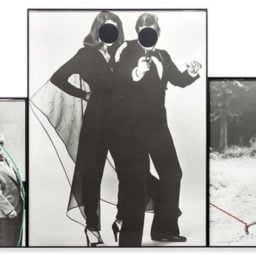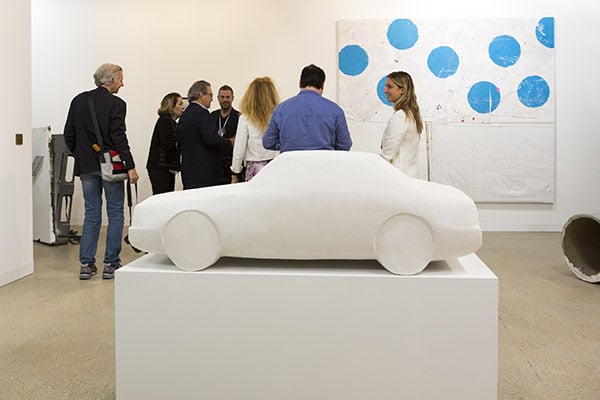

Art Basel is not easily distillable. It’s not really distillable at all. Nonetheless, with so much great work on view, it’s worth the effort to consider the works that stood apart from the rest, for whatever reason. Here are the fruits of that effort.

Art Basel 2016. Photo courtesy Art Basel.
1. Galerie Eva Presenhuber (Zurich)
Human-shaped stone figures by Ugo Rondinone dominated the booth of Zurich-based heavyweight Eva Presenhuber. The sculptures were smaller versions of those seen at Rockefeller Center in Spring 2013 in the “Human Nature” show. Also gracing the booth were brought works by Doug Aitken and Fischli and Weiss, one of the very delectable “car” sculptures from the late 1980s series shown at the Guggenheim Museum in New York this past spring. On the Messeplatz in Basel, gallery artist Oscar Tuazon’s architectural intervention, “Zome Alloy,” paid homage to architect Steve Baer’s iconoclastic 1972 work “Zome House.”
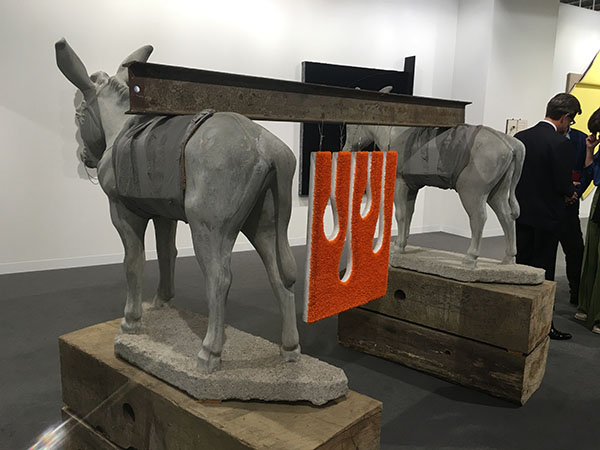
Donald Moffett at Marianne Boesky. Image by artnet News.
2. Marianne Boesky Gallery (New York)
At the center of Marianne Boesky’s booth was a charged work by Donald Moffett composed of one of his seductively cut shag paintings (which look like grass but are paint methodically extruded onto a linen surface) suspended from an iron beam resting atop two sculptural donkeys. Boesky’s gallery also gets kudos for presenting (along with Galleria Continua and Galerie Krinzinger) one of the best and most buzzed-about works on view in Unlimited, Hans Op de Beeck’s mammoth installation Collector’s House, a room that felt like it could have been in the home of a 20th century Robber Baron filled with paintings, books, and a water-lily-filled pond, all crafted from soft grey plaster managing to be simultaneously tranquil and unsettling.

Pierre Klossowski’s Diane and Acteon. Image courtesy of Art Basel.
3. Cabinet (London)
Cabinet’s booth had a witty show-stopping work by Pierre Klossowski, Diana and Acteon, a work comprising a sculpture with a painted backdrop based on the mythic tale of the hunter and the Goddess of the Hunt. As the story goes, the goddess, Diana, was enjoying a bath with her nymphs when the mortal man stumbles onto the tableau. Startling Diana, she splashes water on him transforming him into a deer. When he flees, he’s mauled and killed by his own hounds. The sculpture reinterprets the scene with a lascivious if elegant touch. Also in the booth were works by Mark Leckey, John Knight, and Cosey Fanni Tutti.
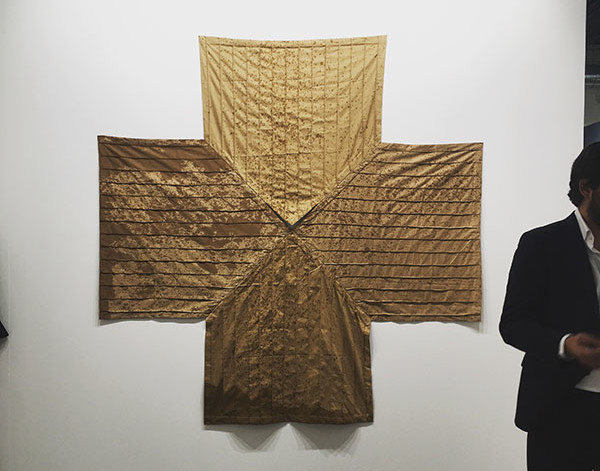
Pia Camil at OMR. Image by artnet News.
4. Galeria OMR (Mexico City)
The booth of Mexico City’s OMR was an astounding ode to Frank Stella’s copper paintings by Pia Camil, who memorably offered ponchos as artwork, or “habitable paintings,” at Frieze New York in 2015. This time around, in a comment on commodification and performance, Camil turned Stella’s paintings into wearable works. The one pictured above doubled as a poncho, but others served as shawls or hooks to hang your coat on.
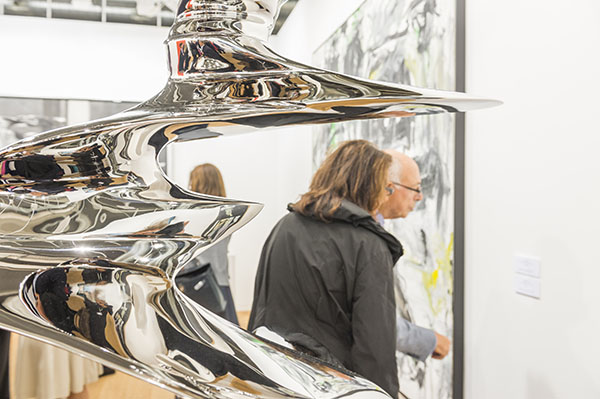
Thaddaeus Ropac installation view. Image courtesy of Art Basel.
5. Galerie Thaddaeus Ropac (Paris, Salzburg)
Ropac had gorgeous paintings by Georg Baselitz and young Romanian artist Adrian Ghenie as well as sculpture by Antony Gormley, Tony Cragg, and a series of studies on board by Alex Katz. Ropac also brought its A game to the Unlimited sector where it showed a monumental 1982 painting, Four Clear Women, by James Rosenquist, which was first shown at Leo Castelli in 1983 and depicts a sleek mash-up of a perfect female face with machinery.

Installation view of Luxembourg & Dayan booth. Image by artnet News.
6. Luxembourg & Dayan (New York, London)
The focused strains of Igor Stravinsky’s score for La Pulcinella, streamed out like a clear siren call summonsing fair-goers to take a break from the messy clashing tones of the fair aisles and into the booth of Luxembourg & Dayan where a violinist and a ballerina recreated Jannis Kounellis’ 1972 work Da inventare sul posto (To Invent on the Spot). The entrancing solo presentation, which made its debut at Documenta 5 in 1972, also featured an abstract pinkish painting with bars of music as a backdrop.

Kurt Schwitters, Ohne Title (Das doppelte Bild) (1942). Image courtesy of Galerie Gmurzynska.
7. Galerie Gmurzynska (Zurich, St. Moritz, Zug)
Galerie Gmurzynska had a presentation of the work of Joan Miró and Kurt Schwitters. Echoing the Schwitters retrospective at the Zurich gallery, in an exhibition space designed by the late Zaha Hadid, the Basel booth recreated some of the architecture.

Sara Cwynar, still from Soft Film. Image by artnet News.
8. Foxy Production (New York)
The hypnotic rhythm of Sara Cwynar’s film-work Soft Film, in Foxy Production’s booth in the Statements sector, was entrancing from the get-go. You see Cwynar collecting and arranging objects she’s purchased on eBay by color, material, and usage in vivid displays that seem to reference in subject and visuals Vito Acconci and Martha Rosler. With a key-motif being the velveteen jewelry box, which you see Cwynar holding in various shapes, colors, and sizes (representing, we’re told in the accompanying text, “soft sexism”), she contemplates the idea of a post-feminist world.
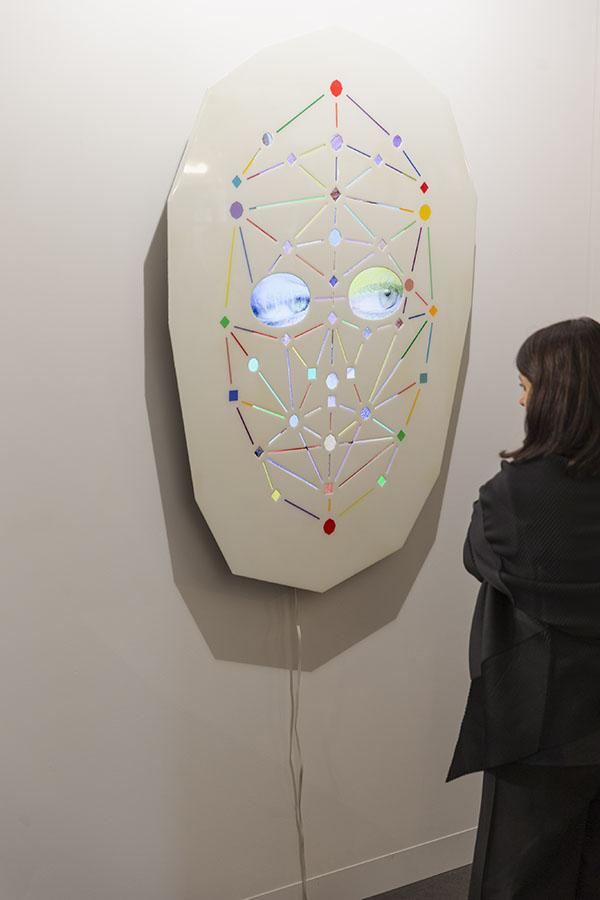
Lisson Gallery installation view with work by Tony Oursler. Image courtesy of Art Basel.
9. Lisson Gallery (London, Milan, New York)
Ai Weiwei’s gnarled sculpture Iron Root took center stage in the booth at Lisson. But sharing the stage was work by Tony Oursler, mobile human eyes projected onto an ovoid white shape and a grid of colorful lines. This was just a sample of Oursler’s work, a variety of which—with mouths that smiled and frowned and emitted almost inaudible sounds, and eyes that blinked and glanced around—delightfully populated an area of the Unlimited sector. Also on view were works by Cory Arcangel, Stanley Whitney, and Anish Kapoor.
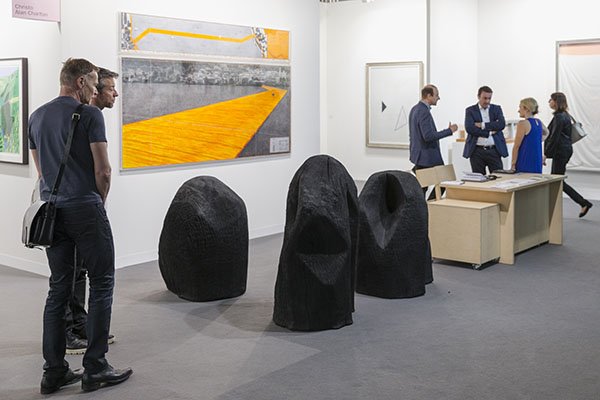
Installation view at Annely Juda Fine Art. Image courtesy of Art Basel.
10. Annely Juda Fine Art (London)
Heavy black sycamore sculptures by David Nash make a pleasing counterpoint to the colorful suite of works on paper by David Hockney lining the exterior of the booth of Annely Juda Fine Art. You’ll also see a model by Christo of Four Store Front Corner Project. Made of found elements of demolished buildings, the full-size version is being shown at the Unlimited sector. Also a treat is the red neon work on canvas and wood by François Morellet, who died in May only a few days after his 90th birthday. At the time, Annely Juda was one of five galleries that had solo shows of Morellet’s work.



